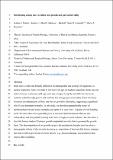Partitioning colony size variation into growth and partial mortality
Abstract
Body size is a trait that broadly influences the demography and ecology of organisms. In unitary organisms, body size tends to increase with age. In modular organisms, body size can either increase or decrease with age, with size changes being the net difference between modules added through growth and modules lost through partial mortality. Rates of colony extension are independent of body size, but net growth is allometric, suggesting a significant role of size-dependent mortality. In this study, we develop a generalizable model of partitioned growth and partial mortality and apply it to data from 11 species of reef-building coral. We show that corals generally grow at constant radial increments that are size independent, and that partial mortality acts more strongly on small colonies. We also show a clear life-history trade-off between growth and partial mortality that is governed by growth form. This decomposition of net growth can provide mechanistic insights into the relative demographic effects of the intrinsic factors (e.g. acquisition of food and life-history strategy), which tend to affect growth, and extrinsic factors (e.g. physical damage, and predation), which tend to affect mortality.
Citation
Madin , J S , Baird , A H , Baskett , M L , Connolly , S R & Dornelas , M A 2020 , ' Partitioning colony size variation into growth and partial mortality ' , Biology Letters , vol. 16 , no. 1 , 2019.0727 . https://doi.org/10.1098/rsbl.2019.0727
Publication
Biology Letters
Status
Peer reviewed
ISSN
1744-9561Type
Journal article
Description
We thank the Australian Research Council for fellowship and research support. M.A.D. is funded by a Leverhulme Fellowship and by the John Templeton Foundation grant no. 60501.Collections
Items in the St Andrews Research Repository are protected by copyright, with all rights reserved, unless otherwise indicated.

